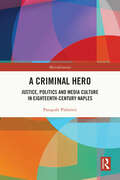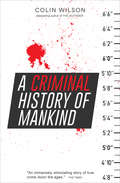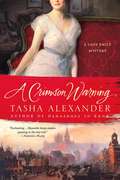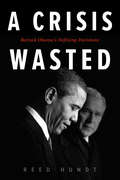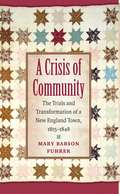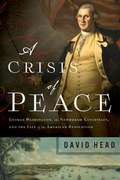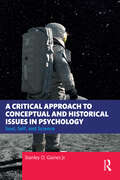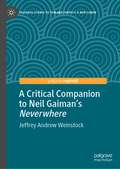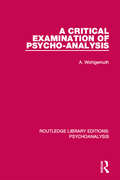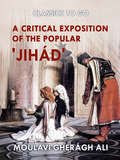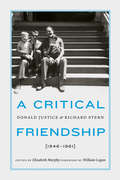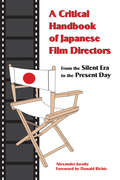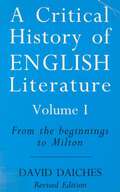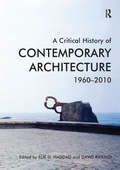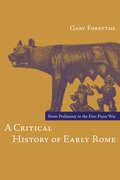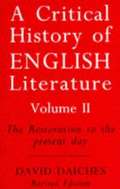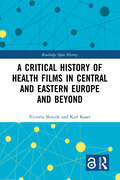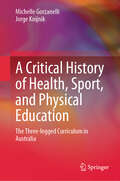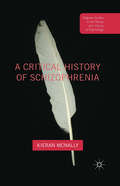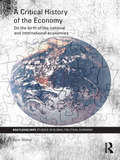- Table View
- List View
A Criminal Hero: Justice, Politics and Media Culture in Eighteenth-Century Naples (ISSN)
by Pasquale PalmieriIn the spring of 1757, the Augustinian friar Leopoldo di San Pasquale was tried in Naples by the hierarchies of his own religious order on charges of financial fraud, heresy, and sexual immorality. He responded by accusing the heads of the convent of subjecting him to a series of inhuman cruelties, claiming to have been "buried alive". While waiting for a final judgment (it was pronounced seven years later, in 1764), the trial of Leopoldo di San Pasquale became a cultural phenomenon unlike any witnessed before in Naples. Cumulatively, reactions to the trial, both during and after it, broke the boundaries separating chronicle and literary fiction, engaged people’s faculties of reason and emotion, and ultimately transformed Leopoldo into a public spectacle—or what we might call today a “celebrity.”Focusing on the scandalous affair of the "buried alive", this book shows how the governing authorities in Naples managed the development of news and stories around current events through their systems of courts and bureaucracies. It also aims to demonstrate how, just as importantly, consumers played an increasing in the spread of information, as means to political empowerment. The sources analyzed call for a microhistorical analysis, as well as for an interdisciplinary discussion with media studies at its conceptual core.A Criminal Hero will appeal to students and scholars alike interested in microhistory, cultural history, media history, history of literature, social and political history, with a focus on the eighteenth century.
A Criminal History of Mankind
by Colin WilsonThis &“immensely stimulating story of true crime down the ages&” tells the history of human violence, from Peking Man to the Mafia (The Times, London). This landmark work offers a completely new approach to the history and psychology of human violence. Its sweep is broad, its research meticulous and detailed. Colin Wilson explores the bloodthirsty sadism of the ancient Assyrians and the mass slaughter by the armies led by Genghis Khan, Tamerlane, Ivan the Terrible, and Vlad the Impaler. He delves into modern history, exploring the genocides practiced by Stalin and Hitler. He then takes a chilling look into the sex crimes and mass murders that have become symbols of the neuroses and intensity of modern life. With breathtaking audacity and stunning insight, Wilson puts criminality firmly in a wide, illuminating historical context. &“A work of massive energy, compulsively readable, splendidly informative . . . it establishes Wilson in a European tradition of thought that includes H. G. Wells, Sartre and Shaw.&” —Time Out London &“A tremendous resource for crime buffs as well as a challenging exposition for some of the more subtle criminological thinking of our time.&” —Kirkus Reviews
A Criminological Imagination: Essays on Justice, Punishment, Discourse (Pioneers In Contemporary Criminology Ser.)
by Pat CarlenA Criminological Imagination contains a selection of key articles from Pat Carlen's research studies of magistrates' courts and women's imprisonment together with a range of other articles on social control, discourse analysis, ideology, punishment, criminology and critique. They are all informed by an assumption that while criminal justice must remain imaginary in societies based upon unequal and exploitative social relations, one task of a criminological imagination might be to suggest why this is so, and how things could be otherwise. This is an invaluable collection for anyone interested in crime, justice and injustice and the social, political and academic contexts in which knowledge of them is constructed.
A Crimson Warning (Lady Emily Mysteries)
by Tasha Alexander<p>Secrets prove deadly in this new novel from Tasha Alexander featuring Lady Emily Hargreaves. Some very prominent people in London are waking up to find their doorsteps smeared with red paint, the precursor to the revelation of a dark secret – and worse – by someone who enjoys destroying lives <p>Newly returned to her home in Mayfair, Lady Emily Hargreaves is looking forward to enjoying the delights of the season. The delights, that is, as defined by her own eccentricities―reading The Aeneid, waltzing with her dashing husband, and joining the Women's Liberal Federation in the early stages of its campaign to win the vote for women. But an audacious vandal disturbs the peace in the capital city, splashing red paint on the neat edifices of the homes of London's elite. This mark, impossible to hide, presages the revelation of scandalous secrets, driving the hapless victims into disgrace, despair and even death. Soon, all of London high society is living in fear of learning who will be the next target, and Lady Emily and her husband, Colin, favorite agent of the crown, must uncover the identity and reveal the motives of the twisted mind behind it all before another innocent life is lost.</p>
A Crisis Wasted: Barack Obama's Defining Decisions
by Reed Hundt&“The blow by blow story of a president and his team wasting the &‘opportunity&’ of the Great Recession to change the fundamentals of the economy.&” —Steven Brill, New York Times–bestselling author This book is the compelling story of President Obama&’s domestic policy decisions made between September 2008 and his inauguration on January 20, 2009. Barack Obama determined the fate of his presidency before he took office. His momentous decisions led to Donald Trump, for Obama the worst person imaginable, taking his place eight years later. This book describes these decisions and discusses how the results could have been different. Based on dozens of interviews with actors in the Obama transition, as well as the author&’s personal observations, this book provides unique commentary of those defining decisions of winter 2008–2009. A decade later, the ramifications of the Great Recession and the role of government in addressing the crisis animate the ideological battle between progressivism and neoliberalism in the Democratic Party and the radical direction of the Republican Party. As many seek the presidency in the November 2020 election, all candidates and of course the eventual winner will face decisions that may be as critical and difficult as those confronted by Barack Obama. This book aims to provide the guidance of history. &“A powerfully lucid, compelling and surprising achievement . . . makes a subtle but irresistible argument that, given the conservative undertow of American politics, liberals and progressives who are serious about change can&’t just wing it but must prepare detailed economic policy analyses and prescriptions long in advance of taking power.&” —Congressman Jamie Raskin, Representative from Maryland&’s 8th District
A Crisis of Community
by Mary Babson FuhrerIn the first decades of the American republic, Mary White, a shopkeeper's wife from rural Boylston, Massachusetts, kept a diary. Woven into its record of everyday events is a remarkable tale of conflict and transformation in small-town life. Sustained by its Puritan heritage, gentry leadership, and sense of common good, Boylston had survived the upheaval of revolution and the creation of the new nation. Then, in a single generation of wrenching change, families, neighbors, church, and town descended into contentious struggle. Examining the tumultuous Jacksonian era at the intimate level of family and community, Mary Babson Fuhrer brings to life the troublesome creation of a new social, political, and economic order centered on individual striving and voluntary associations in an expansive nation.Blending family records and a rich trove of community archives, Fuhrer examines the "age of revolutions" through the lens of a rural community that was swept into the networks of an expanding and urbanizing New England region. This finely detailed history lends new depth to our understanding of a key transformative moment in American history.
A Crisis of Peace: George Washington, The Newburgh Conspiracy, And The Fate Of The American Revolution
by David HeadThe dramatic story of George Washington's first crisis of the fledgling republic. In the war’s waning days, the American Revolution neared collapse when Washington’s senior officers were rumored to approach the edge of mutiny. After the British surrender at Yorktown, the American Revolution blazed on, and as peace was negotiated in Europe, grave problems surfaced at home. The government was broke and paid its debts with loans from France. Political rivalry among the states paralyzed Congress. The army’s officers, encamped near Newburgh, New York, and restless without an enemy to fight, brooded over a civilian population indifferent to their sacrifices. The result was the Newburgh Conspiracy, a mysterious event in which Continental Army officers, disgruntled by a lack of pay and pensions, may have collaborated with nationalist-minded politicians such as Alexander Hamilton, James Madison, and Robert Morris to pressure Congress and the states to approve new taxes and strengthen the central government. A Crisis of Peace tells the story of a pivotal episode of General Washington's leadership and reveals how the American Revolution really ended: with fiscal turmoil, political unrest, out-of-control conspiracy thinking, and suspicions between soldiers and civilians so strong that peace almost failed to bring true independence.
A Critic Writes: Selected Essays by Reyner Banham
by Reyner BanhamFew twentieth-century writers on architecture and design have enjoyed the renown of Reyner Banham. Born and trained in England and a U.S. resident starting in 1976, Banham wrote incisively about American and European buildings and culture. Now readers can enjoy a chronological cross-section of essays, polemics, and reviews drawn from more than three decades of Banham's writings.The volume, which includes discussions of Italian Futurism, Adolf Loos, Paul Scheerbart, and the Bauhaus as well as explorations of contemporary architecture by Frank Gehry, James Stirling, and Norman Foster, conveys the full range of Banham's belief in industrial and technological development as the motor of architectural evolution. Banham's interests and passions ranged from architecture and the culture of pop art to urban and industrial design. In brilliant analyses of automobile styling, mobile homes, science fiction films, and the American predilection for gadgets, he anticipated many of the preoccupations of contemporary cultural studies. Los Angeles, the city that Banham commemorated in a book and a film, receives extensive attention in essays on the Santa Monica Pier, the Getty Museum, Forest Lawn cemetery, and the ubiquitous freeway system.Eminently readable, provocative, and entertaining, this book is certain to consolidate Banham's reputation among architects and students of contemporary culture. For those acquainted with his writing, it offers welcome surprises as well as familiar delights. For those encountering Banham for the first time, it comprises the perfect introduction.
A Critical Approach to Conceptual and Historical Issues in Psychology: Soul, Self, and Science
by Stanley O. Gaines, Jr.A Critical Approach to Conceptual and Historical Issues in Psychology: Soul, Self, and Science examines the evolving concept of human consciousness throughout the ages to show how humanity progressed from ‘studies of the soul’ – a major concern of ancient philosophy – to a science of the mind including the self – a primary concern of contemporary psychology.Divided into five parts, the book moves through the history of psychology from its philosophical roots into the present day and beyond. It takes a balanced and critical approach to figures and theories which have been instrumental in the development of psychology as a discipline, such as Plato, Descartes, Wundt, Du Bois, Freud, Jung, Watson, Skinner, and Maslow. Throughout, it offers diverse perspectives on the field’s history, providing insights into such topics as race and intelligence, gender and personality, and their treatment within psychology. Each chapter is supported by breakout boxes highlighting key theories related to that chapter’s topic. Thought questions, to encourage the reader to critically evaluate what they have read, notes with further information, and suggestions for further reading are provided online.Of particular interest to postgraduate students on MSc conversion courses, the book will also interest undergraduate students completing history of psychology, conceptual and historical issues in psychology, history and systems of psychology, and related modules. This textbook was designed to comply with the QAA Subject Benchmark Statement in Psychology and the BPS accreditation guidelines for content in Conceptual and Historical Issues in Psychology
A Critical Companion to Neil Gaiman's "Neverwhere" (Palgrave Science Fiction and Fantasy: A New Canon)
by Jeffrey Andrew WeinstockFantasy author Neil Gaiman’s 1996 novel Neverwhere is not just a marvelous self-contained novel, but a terrifically useful text for introducing students to fantasy as a genre and issues of adaptation. Jeffrey Andrew Weinstock’s briskly written A Critical Companion to Neil Gaiman’s Neverwhere offers an introduction to the work; situates it in relation to the fantasy genre, with attention in particular to the Hero’s Journey, urban fantasy, word play, social critique, and contemporary fantasy trends; and explores it as a case study in transmedial adaptation. The study ends with an interview with Neil Gaiman that addresses the novel and a bibliography of scholarly works on Gaiman.
A Critical Discourse Study of the "Chinese Dream": Context, Discursive Construction, and Media Representation (Cultural Discourse Studies Series)
by Junchen ZhangZhang’s book focuses on the analysis of the sociohistorical context, linguistic patterns of discursive construction, and media representations of the “Chinese Dream” in Mainland China, Hong Kong, and the United States.Analyzing data from the Chinese leader’s speeches and articles from China Daily, the South China Morning Post, and the New York Times, the author provides insights into the understanding of contemporary Chinese society through a critical discourse analysis of the “Chinese Dream” and its mediatized construction. Focusing on the discursive construction, the book examines the Chinese leader Xi Jinping’s narratives on the “Chinese Dream” from multidimensional perspectives, such as thematic representations, discursive strategies, and narrative frames, which emphasize the overall structure of the “Chinese Dream” as a political discourse. Methodologically, Zhang combines a discourse-historical approach, corpus linguistics, and framing analysis into a complementary framework, which draws merits from the three approaches.This innovative research volume will be of interest to academics, researchers, and students in the fields of discourse analysis, political research, Chinese politics, and East Asian studies.
A Critical Examination of Psycho-Analysis (Routledge Library Editions: Psychoanalysis)
by A. WohlgemuthOriginally published in 1923, this title is a critical examination of Freud’s theory of psychoanalysis. A contemporary of Freud, the author sets out to evaluate his theories in a scientific manner, searching for evidence. The result is a rather scathing review of where this is lacking.
A Critical Exposition of the Popular 'Jihád' (The World At War)
by Cherágh AliA Critical Exposition of the Popular 'Jihád' Showing that all the Wars of Mohammad Were Defensive; and that Aggressive War, or Compulsory Conversion, is not Allowed in The Koran - 1885
A Critical Friendship: Donald Justice and Richard Stern, 1946-1961
by Donald Justice, Richard SternA chance meeting in the University of North Carolina campus library in 1944 began a decades-long friendship and sixty-year correspondence. Donald Justice (1925–2004) and Richard Stern (1928–2013) would go on to become, respectively, the Pulitzer Prize–winning poet and the acclaimed novelist. A Critical Friendship showcases a selection of their letters and postcards from the first fifteen years of their correspondence, representing the formative period in both writers&’ careers. It includes some of Justice&’s unpublished poetry and early drafts of later published poems as well as some early, never-before-published poetry by Stern.A Critical Friendship is the story of two writers inventing themselves, beginning with the earliest extant letters and ending with those just following their first major publications, Justice&’s poetry collection The Summer Anniversaries and Stern&’s novel Golk. These letters highlight their willingness to give and take criticism and document the birth of two distinct and important American literary lives. The letters similarly document the influence of teachers, friends, and contemporaries, including Saul Bellow, John Berryman, Edgar Bowers, Robert Lowell, Norman Mailer, Allen Tate, Peter Hillsman Taylor, Robert Penn Warren, Eudora Welty, and Yvor Winters, all of whom feature in the pair's conversations. In a broader context, their correspondence sheds light on the development of the mid-twentieth-century American literary scene.
A Critical Handbook of Japanese Film Directors
by Donald Richie Alexander JacobyThis important work fills the need for a reasonably priced yet comprehensive volume on major directors in the history of Japanese film. With clear insight and without academic jargon, Jacoby examines the works of over 150 filmmakers to uncover what makes their films worth watching.Included are artistic profiles of everyone from Yutaka Abe to Isao Yukisada, including masters like Kinji Fukasaku, Juzo Itami, Akira Kurosawa, Takashi Miike, Kenji Mizoguchi, Yasujiro Ozu, and Yoji Yamada. Each entry includes a critical summary and filmography, making this book an essential reference and guide.UK-based Alexander Jacoby is a writer and researcher on Japanese film.
A Critical History Of English Literature: From The Beginnings To Milton - Volume-1
by David Daiches"A Critical History of English Literature: The Restoration to the Present Day Volume-I" by David Daiches provides a comprehensive examination of English literature from the Restoration period onwards. Beginning with the tumultuous historical events that characterized the Restoration era, Daiches navigates through the subsequent literary epochs with scholarly precision. The book explores the emergence of various literary genres, the evolution of critical thought, and the contributions of key figures in shaping the literary landscape. Daiches's critical insights illuminate the connections between literature and the broader cultural, social, and political contexts of each period. This volume serves as an essential resource for readers seeking a thorough understanding of the foundational developments in English literature, making it a valuable companion for students, scholars, and enthusiasts interested in the multifaceted journey of English literary history.
A Critical History and Philosophy of Psychology
by Richard T. G. Walsh Thomas Teo Angelina Baydala Richard T. G. Walsh Thomas TeoIn line with the British Psychological Society's recent recommendations for teaching the history of psychology, this comprehensive undergraduate textbook emphasizes the philosophical, cultural and social elements that influenced psychology's development. The authors demonstrate that psychology is both a human (i. e. psychoanalytic or phenomenological) and natural (i. e. cognitive) science, exploring broad social-historical and philosophical themes such as the role of diverse cultures and women in psychology, and the complex relationship between objectivity and subjectivity in the development of psychological knowledge. The result is a fresh and balanced perspective on what has traditionally been viewed as the collected achievements of a few 'great men'. With a variety of learning features, including case studies, study questions, thought experiments and a glossary, this new textbook encourages students to critically engage with chapter material and analyze themes and topics within a social, historical and philosophical framework.
A Critical History of Contemporary Architecture: 1960-2010
by Elie G. Haddad David Rifkind1960, following as it did the last CIAM meeting, signalled a turning point for the Modern Movement. From then on, architecture was influenced by seminal texts by Aldo Rossi and Robert Venturi, and gave rise to the first revisionary movement following Modernism. Bringing together leading experts in the field, this book provides a comprehensive, critical overview of the developments in architecture from 1960 to 2010. It consists of two parts: the first section providing a presentation of major movements in architecture after 1960, and the second, a geographic survey that covers a wide range of territories around the world. This book not only reflects the different perspectives of its various authors, but also charts a middle course between the 'aesthetic' histories that examine architecture solely in terms of its formal aspects, and the more 'ideological' histories that subject it to a critique that often skirts the discussion of its formal aspects.
A Critical History of Early Rome: From Prehistory to the First Punic War
by Gary ForsytheDuring the period from Rome's Stone Age beginnings on the Tiber River to its conquest of the Italian peninsula in 264 B.C., the Romans in large measure developed the social, political, and military structure that would be the foundation of their spectacular imperial success. In this comprehensive and clearly written account, Gary Forsythe draws extensively from historical, archaeological, linguistic, epigraphic, religious, and legal evidence as he traces Rome's early development within a multicultural environment of Latins, Sabines, Etruscans, Greeks, and Phoenicians. His study charts the development of the classical republican institutions that would eventually enable Rome to create its vast empire, and provides fascinating discussions of topics including Roman prehistory, religion, and language. In addition to its value as an authoritative synthesis of current research, A Critical History of Early Rome offers a revisionist interpretation of Rome's early history through its innovative use of ancient sources. The history of this period is notoriously difficult to uncover because there are no extant written records, and because the later historiography that affords the only narrative accounts of Rome's early days is shaped by the issues, conflicts, and ways of thinking of its own time. This book provides a groundbreaking examination of those surviving ancient sources in light of their underlying biases, thereby reconstructing early Roman history upon a more solid evidentiary foundation.
A Critical History of English Literature: The Restoration to the present day - Volume-2
by David Daiches"A Critical History of English Literature: The Restoration to the Present Day Volume-II" by David Daiches offers a comprehensive exploration of English literature from the Restoration period to the contemporary era. Daiches critically analyzes the evolution of literary trends, genres, and individual works during this expansive time frame. The book delves into the societal, cultural, and political contexts that influenced literary production, providing readers with a nuanced understanding of the dynamic relationship between literature and the changing landscapes of British history. Daiches skillfully navigates through major movements, key authors, and seminal works, offering insightful interpretations and evaluations. The volume serves as an invaluable resource for students, scholars, and enthusiasts seeking a deeper appreciation and critical assessment of English literature from the Restoration period to the present day.
A Critical History of Health Films in Central and Eastern Europe and Beyond (Routledge Open History)
by Victoria Shmidt Karl KaserThe burgeoning scholarship on Western health films stands in stark contrast to the vacuum in the historical conceptualization of Eastern European films. This book develops a nonlinear historical model that revises their unique role in the inception of national cinematography and establishing supranational health security. Readers witness the revelation of an unknown history concerning how the health films produced in Eastern European countries not only adopted Western patterns of propaganda but actively participated in its formation, especially with regard to those considered “others”: Women and the populations of the periphery. The authors elaborate on the long “echo” of the discursive practices introduced by health films within public health propaganda, as well as the attempts to negate and deconstruct such practices by rebellious filmmakers. A wide range of methods, including the analysis of the sociological biographies of filmmakers, the historical reconstruction of public campaigns against diseases and an investigation into the production of health films, contextualizes these films along a multifaceted continuum stretching between the adaptation of global patterns and the cultivation of national authenticities. The book is aimed at those who study the history of film, the history of public health, Central and Eastern European countries and global history.
A Critical History of Health, Sport, and Physical Education: The Three-legged Curriculum in Australia
by Jorge Knijnik Michelle GorzanelliThis book fills a gap in literature by generating a combined history of Physical Education (PE), School Sport (SS) and Health Education (HE) in New South Wales (NSW) public schools from 1880 to 2024. It includes broad discussions on how political issues such as the World Wars influenced (i) the PE curriculum, which was used as a medium to prepare a &‘fit&’ army, (ii) the school sport system, which acted as an expression of national strength via showcasing sporting prowess on the international stages of the Olympic Games, and (iii) the health education curriculum, which addressed infectious diseases resulting from poor hygiene associated with poverty. The book also adopts a socio-cultural perspective to the constructs of PE, SS, and HE curricula and highlights significant local, national, and international historical events and issues as factors driving curriculum developments and paradigm shifts in these subjects in the NSW public education and beyond. It brings new and engendering socio-historical findings to the discipline fields of PE, SS, and HE, combined with an innovative methodology in critical historiographical studies.
A Critical History of Psychology: From Antiquity to Modernity
by Thomas Hardy LeaheyThis fully updated and refreshed 9th edition places social, economic and political forces of change alongside psychology’s internal theoretical and empirical arguments. It utilizes a critical lens to illuminate the way in which the external world has shaped the development of psychology and, in turn, how psychology from antiquity to modernity has shaped society.The text approaches the material from an integrative, rather than wholly linear, perspective, carefully examining how issues in psychology reflect and affect concepts that lie outside the field of psychology’s technical concerns as a science and profession.Key features of this edition include: A newly reconsidered structure, including five additional interludes exploring historical background narratives and the rise of modernity, to allow for flexible and adaptable textbook use. Expanded exploration of the two psychologies: the Way of Ideas, driven by epistemology and unique to Europe, and The Way of Human Nature, a universal concern to find a science of human behavior and its management. Including scientific, applied, and professional psychology, as well as coverage of the social sciences and social policy implications, this book is appropriate for high-level undergraduate and graduate students.
A Critical History of Schizophrenia (Palgrave Studies in the Theory and History of Psychology)
by Kieran McNallySchizophrenia was 20th century psychiatry's arch concept of madness. Yet for most of that century it was both problematic and contentious. This history explores schizophrenia's historic instability via themes such as symptoms, definition, classification and anti-psychiatry. In doing so, it opens up new ways of understanding 20th century madness.
A Critical History of the Economy: On the birth of the national and international economies (RIPE Series in Global Political Economy)
by Ryan WalterDrawing on recent debates in critical International Political Economy, this book mobilizes the idea that the economy does not exist separately from society and politics to develop a detailed intellectual history of how the economy came to be seen as an independent domain. In contrast to typical approaches to writing the history of economic thought, which assume the reality of the economy, the author describes the forms of intellectual argument that made it possible to conceive of the national and international economies as objects of intellectual inquiry. At the centre of this process was the analytical separation of power and wealth. Walter thus offers a broad historical perspective on the emergence of current IPE theory, while linking the field with contextualist intellectual history. This important and innovative volume will be of strong interest to students and scholars of International Political Economy, International Relations, Economics, History and Political Theory.
